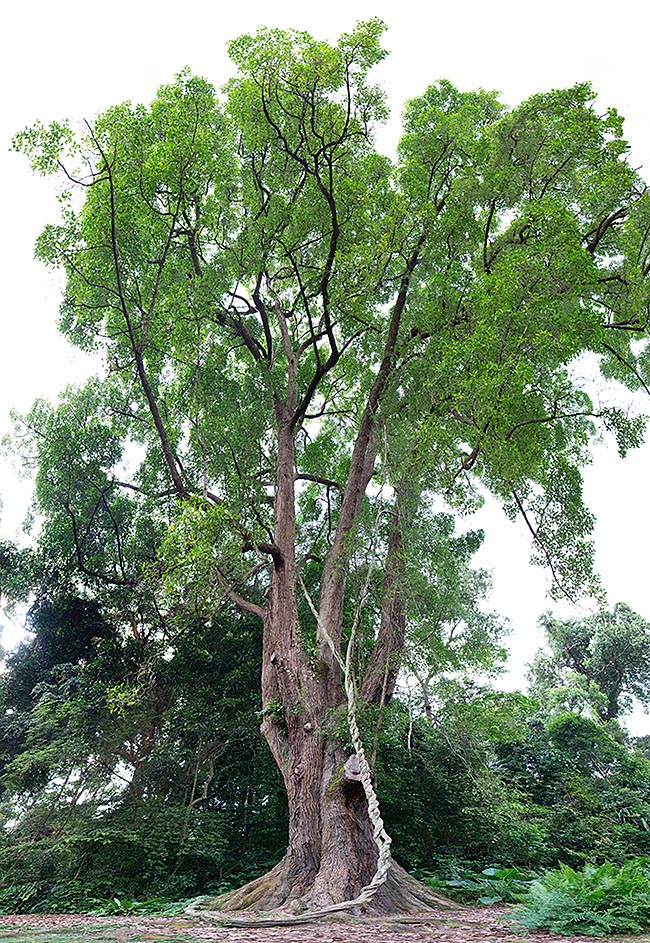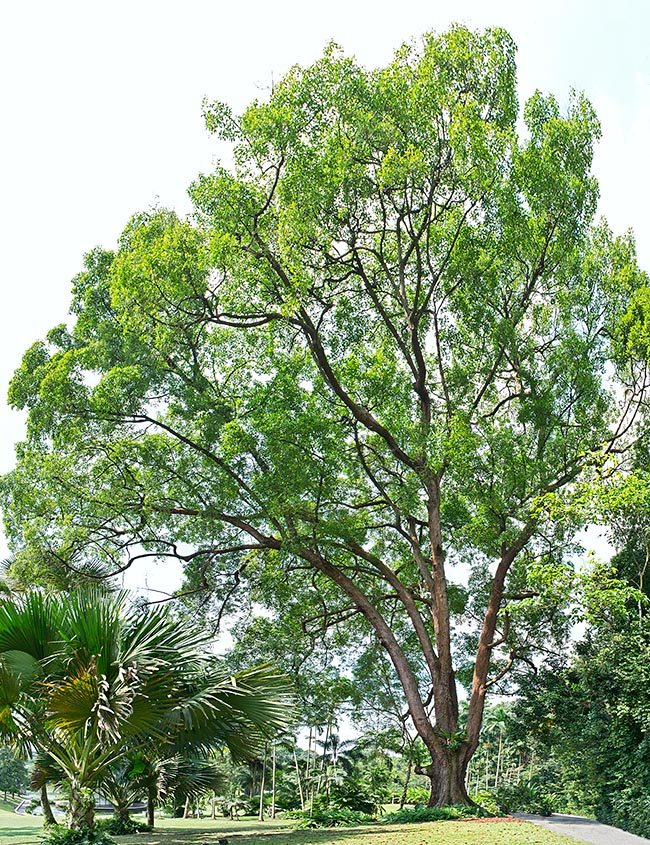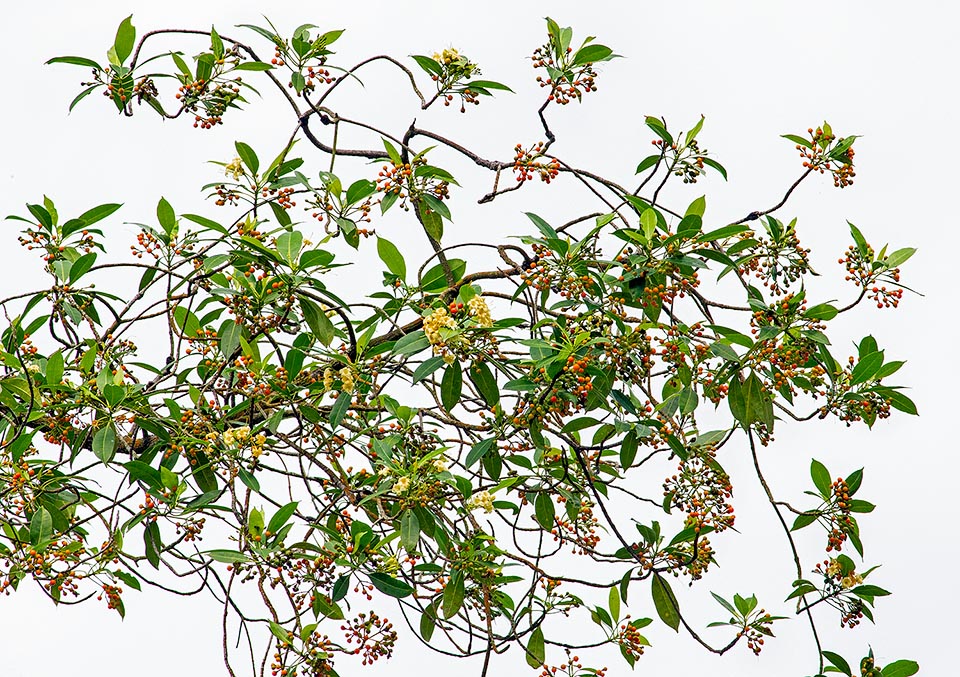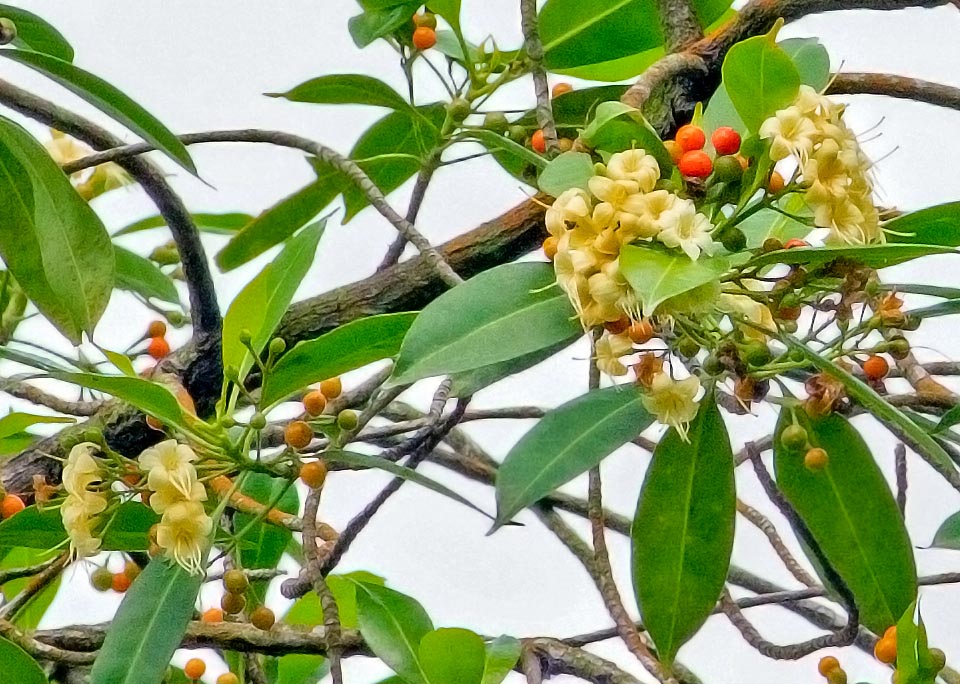Family : Gentianaceae

Text © Pietro Puccio

English translation by Mario Beltramini

With its 35 m of height, Fagraea fragrans is an exotic relative to the gentians © Giuseppe Mazza
The species is native to Andaman and Nicobar Islands, Cambodia, India, Indonesia, Laos, Malaysia, Myanmar, Papua New Guinea, Philippines, Singapore, Thailand and Vietnam where it grows in the humid forests, mostly in open spaces, along the banks of the rivers and at the margins of the marshes periodically flooded, up to about 600 m of altitude.
The genus is honoured to the Swedish naturalist Jonas Theodor Fagraeus (1729-1797); the name of the species is the Latin term “fragrans” = perfumed, fragrant, with reference to the flowers.
Common names: ironwood (English); ta trao (Cambodian); tembesu, tembusu (Malay); kan krao, man pa, tham sao (Thai); tatrao, trai (vietnamese).
The Fagraea fragrans Roxb. (1824) is a slow-growing evergreen tree, up to more than 35 m tall, with trunk which may exceed the 130 cm of diameter, with dark brown to blackish bark, longitudinally and deeply fissured, and conical crown in the young plants, expanded and irregular in the adult ones.
The leaves, on a 1-2 cm long petiole, are opposite, simple, entire, elliptic to lanceolate or oblong-lanceolate, coriaceous, 5-13 cm long and 2-5 cm broad, with more or less pointed apex, of pale green colour.
The inflorescences are axillar corymbs, produced in the terminal part of the branches, carrying numerous hermaphrodite funnel-shaped flowers of cream white colour tending to the yellow, 0,8-2,2 cm long and of about 2 cm of diameter, with 5 lobes having five 1,8-2,2 cm long stamina inserted on the corolla, intensely fragrant especially in the evening.
The pollination is performed by nocturnal butterflies.
The fruits are globose berries of about 0,8 cm of diameter, initially green, then orange tending to the scarlet red when ripe, containing numerous tiny seeds, of less than 1 mm of diameter, in good part sterile.

The wood is hard and firm, the bark an antipyretic and the leaves treat the dysentery © Giuseppe Mazza
They are dispersed by birds and bats that nourish of its fruits.
It reproduces by seed which is to be interred in short time, having a little lasting germinative capability, in sterilized sandy loam kept humid at the temperature of 22-24 °C, with germination times of 2-8 weeks.
The reproduction by root suckers is also easy.
Imposing and easily adaptable species, cultivable in full sun in the tropical and humid subtropical climate zones, as it does not bear drops of temperature near to 0 °C unless exceptional and for a quite short period.
It is not particular about the soil, as it can grow indifferently on light, sandy, even poor soils, as well as on heavy, clayey and little draining ones. It is widely utilized for its ornamental characteristic in parks and gardens and as road tree, in particular in its origin countries.
The wood, of yellow colour, is particularly hard, compact, long lasting and easy to work, resistant to the atmospheric agents and to the termites attack.
In the past, it was utilized for railway sleepers and in the constructions of houses, boats, frames and bridges; it is furthermore excellent for burning and for producing charcoal.
In recent times its commercial exploitation on a large scale has considerably reduced and now it is utilized in a quite limited measure, seen that the number of adult plants has drastically decreased due to the excessive exploitation and the reduction of the habitat; the species is nowadays locally protected. The bark is used in the traditional medicine as antipyretic and the leaves of the young branches, under form of decoction, for the treatment of the dysentery.

The flowers, very fragrant especially in the evening, are pollinated by nocturnal moths. The fruits, red when ripe, are dispersed by birds and bats © Giuseppe Mazza

Enlarging a detail we see that, colour apart, the flowers have rightly the shame shape of gentians. Evolutionary speaking, in the green world the flower architecture is an important taxonomists Ariadne’s tread. The flowers are just the plants sexual organs and nature is very conservative in this © Giuseppe Mazza
Synonyms: Cyrtophyllum peregrinum Reinw. (1826); Willughbeia fragrans Spreng. (1827); Fagraea peregrina (Reinw.) Blume (1838); Cyrtophyllum fragrans (Roxb.) DC. (1845); Cyrtophyllum lanceolatum DC. (1845); Cyrtophyllum giganteum Ridl. (1923); Fagraea ridleyi Gand. (1924).
→ To appreciate the biodiversity within the GENTIANACEAE family please click here.
